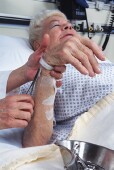
WEDNESDAY, Sept. 28 (HealthDay News) — Almost one in every five patients with advanced Alzheimer’s or other form of severe dementia will be shuttled from a nursing home to a hospital during their last few months of life, a new U.S. study shows.
The study’s authors believe that many of those troublesome “transitions” aren’t needed.
Depending on where a patient lives, as many as 37.5 percent may be hospitalized, the study found.
“This study is really a sign of the current inefficiency of how we organize and pay for health care. The current incentive for patients with severe dementia is to hospitalize and get them stuck in a revolving door between acute care hospitals and nursing homes,” explained study co-author Dr. Joan Teno, a professor of health services, policy and practice at the Warren Alpert Medical School at Brown University in Providence, R.I.
Results of the study are published in the Sept. 29 issue of the New England Journal of Medicine.
Teno and her colleagues looked at Medicare data from 2000 through 2007, involving almost 475,000 patients. The researchers focused on individuals with advanced mental and functional impairments who were in a nursing home at least 120 days before their deaths.
The authors defined transitions from nursing homes to hospitals as “burdensome” if the hospitalization occurred in the last three days of life, if they were sent to a different nursing home after hospitalization, or if there were multiple hospitalizations during the last 90 days of life.
“These were people who had really advanced cognitive impairment and really impaired functional living. They couldn’t perform normal tasks of daily living. About one in five of these patients will have one or more transitions that are burdensome,” said Teno.
Different areas of the country had varying rates of burdensome transitions. In Alaska, the percentage of patients experiencing at least one burdensome transition was just 2 percent, while in Louisiana it was 37.5 percent, the investigators found.
What’s more, areas with higher rates of burdensome transitions also had higher rates of poorer outcomes.
“People who live in a region with the highest rates of burdensome transitions have almost a twofold increase in the number of stage IV decubitus ulcers — that’s a bedsore with bone exposed. They’re also twice as likely to stay in the ICU [intensive care unit], and they are threefold more likely to have a feeding tube inserted,” noted Teno.
“What’s really distressing is that when you take someone with a severe level of cognitive impairment out of their usual routine, they just don’t do well. I can achieve better outcomes if I can treat them in the nursing home,” she said.
But, the current way that Medicare and Medicaid pay nursing homes and hospitals encourages these types of transitions by offering additional incentives for patients who’ve been hospitalized, according to the study.
“There are substantial risks of hospitalization. Families need to know that there are risks to hospitalizations as well as benefits. But, not all hospitalizations are unnecessary or preventable. Trying to prevent every hospitalization would not be appropriate and would have negative consequences on overall care quality,” said Dr. Joseph Ouslander, a professor and senior associate dean for geriatric programs at the Charles E. Schmidt College of Medicine at Florida Atlantic University in Boca Raton.
However, he added that, “there are clearly some situations where patients don’t need to be sent to the hospital, and care can be improved at a reduced cost in morbidity and discomfort as well as actual costs. The way things are being done is not the best care.”
In addition to the current way hospitals and nursing homes are paid by Medicare and Medicaid, Ouslander said that concerns about legal liability may be another factor in unnecessary hospitalizations. He said current laws may need to be reformed.
“A lot of lawsuits stem from bad outcomes, not necessarily from bad care, and by nature, nursing homes will often have bad outcomes,” said Ouslander, who also co-authored an editorial in the same issue of the journal.
Teno said that one solution is to have a so-called medical home, such as a nurse practitioner who reviews all care decisions. “Medical homes help align incentives to provide the right care at the right time for the right person,” she said.
She added that families with loved ones in nursing homes can request a “Do not hospitalize” order. That way, the nursing home doesn’t automatically send a patient to the hospital. Instead, the nursing home staff consults the family about their loved one’s change in health and discusses the risks and benefits of each care option with the family.
More information
Learn more about evaluating caregivers for your loved one from the Alzheimer’s Association.

